May 27, 2016
Spring 2016 Edition of ASCSA Newsletter
A special excavation issue covering activities at the Athenian Agora, Ancient Corinth, and School-affiliated excavations is now available for viewing online.
Read MoreMay 26, 2016
American School and Gennadius Library Celebrate Anniversaries with Gala
Agora Excavations Director John Camp and the A.G. Leventis Foundation were both recognized for their contributions at the May 12th event in New York City.
Read MoreMay 23, 2016
Προστασία και αξιοποίηση των ελληνικών αρωματικών φυτών σε Βοτανικούς Κήπους
Σεμινάριο στο πλαίσιο της έκθεσης Flora Graeca πραγματοποίησε η Δρ. Ελένη Μαλούπα, την Πέμπτη 19 Μαΐου στην αίθουσα Μανδύλα της Γενναδείου Βιβλιοθήκης.
Read MoreMay 18, 2016
Flora Graeca Prodromus
Ομιλία στο πλαίσιο της έκθεσης "Flora Graeca" πραγματοποιήθηκε την Τρίτη 17 Μαΐου, στις 4μμ, στο Αναγνωστήριο Σπάνιων Βιβλίων Μανδύλα. Η ομιλία έγινε από την κα Σόφη Παπαγεωργίου, Head Librarian Emerita της Γενναδείου Βιβλιοθήκης.
Read MoreMay 12, 2016
The Magic of Botanical Art, Seminar on May 28
The Gennadius Library is organizing a seminar of botanical painting entitled 'The Magic of Botanical Art'. The seminar will be conducted by Maggie Niagassas and will take place on Saturday May 28, 10:00 am-1:00 pm, at the Mandylas Rare Book Reading Room.
Read MoreMay 11, 2016
Hesperia 85.2 Now Online!
Topics in this issue include burials in the Ayia Triada Cave on Euboia, MH Fine Gray Burnished pottery from Mitrou, wheel-coiled vs. wheel-thrown pottery manufacture in the Protogeometric period, the development of the Athenian inscribed stone stele, and the encouragement of euergetism in Athenian honorific decrees.
Read More
May 11, 2016
Η μαγεία της βοτανικής τέχνης
Στο πλαίσιο της έκθεσης Flora Graeca, η Γεννάδειος Βιβλιοθήκη διοργάνωσε σεμινάριο βοτανικής ζωγραφικής για ενήλικες με θέμα "‘Η μαγεία της βοτανικής τέχνης". Το σεμινάριο, που έγινε από την εικαστικό Maggie Niagassas, Σάββατο 28 Μαΐου 2016.
Read MoreMay 11, 2016
Gennadius Library closed on June 6
The Gennadius Library will remain closed to the public on Monday, June the 6th.
Read More
April 25, 2016
VIDEOCAST - Ολοκληρωμένη Διαχείριση Τοπίων Προκλήσεις και Προοπτικές
ASCSA, Med-Ina, and PIOP
Read MoreApril 22, 2016
Θεραπευτικά φυτά: τα φάρμακα που ταξιδεύουν
Σεμινάριο στο πλαίσιο της έκθεσης "Flora Graeca" πραγματοποιήθηκε την Πέμπτη 21 Απριλίου στην αίθουσα Μανδύλα της Γενναδείου Βιβλιοθήκης. Την ομιλία με θέμα "Θεραπευτικά φυτά: τα φάρμακα που ταξιδεύουν" έδωσε η Πόπη Σεριάτου.
Read More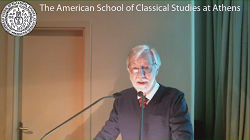
April 20, 2016
VIDEOCAST - Flora Graeca Sibthorpiana and the botanical exploration of Greece
Arne Strid, Professor emeritus, former Director of the Göteborg Botanical Garden
Read More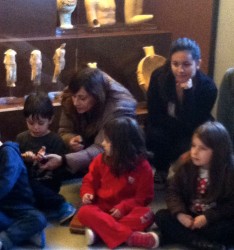
April 19, 2016
Outreach at Corinth Excavations
Looking for a lesson plan? A video showing conservation of the beautiful Eutychia mosaic? Check out Corinth Excavation's outreach page.
Read MoreApril 18, 2016
Από τον βοτανόκηπο στον βοτανικό κήπο. Βοτανικός κήπος Κεφαλονιάς
Σεμινάριο με θέμα "Από τον βοτανόκηπο στον βοτανικό κήπο. Βοτανικός Κήπος Κεφαλονιάς" πραγματοποιήθηκε την Πέμπτη 14 Απριλίου στο πλαίσιο της έκθεσης της Γενναδείου Βιβλιοθήκης "Flora Graeca". Την ομιλία έδωσε ο κος Σπύρος Κοσμετάτος στο αμφιθέατρο Cotsen Hall.
Read MoreApril 13, 2016
A Finding Aid for the Pylos Excavations Archive
A new finding aid for the Pylos Excavations Archive has replaced the old inventory.
Read MoreApril 6, 2016
Τα λουλούδια της Πρωτομαγιάς στους ελαιώνες του Μυστρά
Την Τρίτη 5 Απριλίου πραγματοποιήθηκε σεμινάριο με θέμα Τα λουλούδια της Πρωτομαγιάς στους ελαιώνες του Μυστρά στο πλαίσιο της έκθεσης "Flora Graeca".
Read More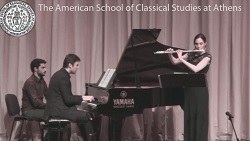
April 1, 2016
VIDEOCAST - Connections: A Flute & Piano Recital in the Greek & American Spirit
by Natalia Gerakis (flute) and Apostolos Palios (piano)
Read MoreApril 1, 2016
Πρώιμες Προσωποποιήσεις της Ελλάδας (15ος-18ος αι.)
Διάλεξη με θέμα Πρώιμες Προσωποποιήσεις της Ελλάδας (15ος-18ος αι.) έδωσε ο Αναπληρωτής Καθηγητής του Τμήματος Αρχειονομίας και Βιβλιοθηκονομίας του Ιονίου Πανεπιστημίου Γιάννης Κόκκωνας. Η διάλεξη πραγματοποιήθηκε στις 29 Μαρτίου στο αμφιθέατρο Cotsen Hall.
Read MoreApril 1, 2016
Ανακαλύπτοντας την ελληνική φύση τον 18ο αιώνα
Στο πλαίσιο της έκθεσης "Flora Graeca" πραγματοποιήθηκε, στις 31 Μαρτίου στην αίθουσα Μανδύλα της Γενναδείου Βιβλιοθήκης, σεμινάριο με θέμα "Ανακαλύπτοντας την ελληνική φύση τον 18ο αιώνα". Την ομιλία έκανε η κα Βάσω Σειρηνίδου, επίκουρη καθηγήτρια Νεοελληνικής Ιστορίας στο Τμήμα Ιστορίας και Αρχαιολογίας του ΕΚΠΑ.
Read MoreMarch 31, 2016
Τα φαρμακευτικά φυτά: από τον μύθο στην ιστορία
Σεμινάριο στο πλαίσιο της έκθεσης "Flora Graeca" από τον Δημήτρη Μητουλάκη, Ιστορικό, Υποψήφιο Διδάκτορα ΕΚΠΑ.
Read More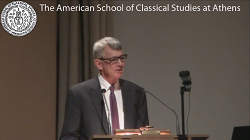
March 28, 2016
VIDEOCAST-New Sophistry:Reassessing the Importance of the Sophists in the Life of 5th Century Greece
Prof. Richard McKirahan, Pomona College
Read MoreMarch 15, 2016
SOCIAL MEDIA COMMUNITY MANAGER
The American School of Classical Studies at Athens seeks a Social Media Community Manager, resident in Athens, Greece, at the main campus. The successful candidate will manage all social media to promote the activities of the ASCSA in Greece, among its large higher education and public constituencies in the United States, and globally.
Read MoreMarch 9, 2016
Hesperia 85.1 Now Online!
Topics in this issue include the Molyvoti, Thrace, Archaeological Project, a Mycenaean quarry, Aegean prehistory prior to Schliemann, erotic curse tablets, Athenian taxes, and a rediscovered Athenian pinakion.
Read MoreMarch 7, 2016
Lerna VII: The Neolithic Settlement Published
Lerna VII: The Neolithic Settlement is now published and available for purchase.
Read More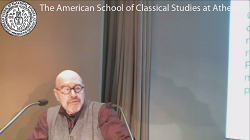
February 25, 2016
VIDEOCAST - Murder on Black Mountain: Love and Death on a Nineteenth Century Greek Island
Thomas W. Gallant, University of California San Diego
Read More